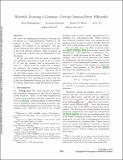| dc.contributor.author | Stewart, Alistair | |
| dc.contributor.author | Diakonikolas, Ilias | |
| dc.contributor.author | Kamath, Gautam Chetan | |
| dc.contributor.author | Kane, Daniel M | |
| dc.contributor.author | Li, Jerry Zheng | |
| dc.contributor.author | Moitra, Ankur | |
| dc.date.accessioned | 2018-06-11T17:27:24Z | |
| dc.date.available | 2018-06-11T17:27:24Z | |
| dc.date.issued | 2018-01 | |
| dc.identifier.issn | 0368-4245 | |
| dc.identifier.uri | http://hdl.handle.net/1721.1/116214 | |
| dc.description.abstract | We study the fundamental problem of learning the parameters of a high-dimensional Gaussian in the presence of noise | where an "-fraction of our samples were chosen by an adversary. We give robust estimators that achieve estimation error O(ϵ) in the total variation distance, which is optimal up to a universal constant that is independent of the dimension. In the case where just the mean is unknown, our robustness guarantee is optimal up to a factor of p 2 and the running time is polynomial in d and 1/ϵ. When both the mean and covariance are unknown, the running time is polynomial in d and quasipolynomial in 1/ϵ. Moreover all of our algorithms require only a polynomial number of samples. Our work shows that the same sorts of error guarantees that were established over fifty years ago in the one-dimensional setting can also be achieved by efficient algorithms in high-dimensional settings. | en_US |
| dc.publisher | Society for Industrial and Applied Mathematics | en_US |
| dc.relation.isversionof | http://dx.doi.org/10.1137/1.9781611975031.171 | en_US |
| dc.rights | Article is made available in accordance with the publisher's policy and may be subject to US copyright law. Please refer to the publisher's site for terms of use. | en_US |
| dc.source | SIAM | en_US |
| dc.title | Robustly Learning a Gaussian: Getting Optimal Error, Efficiently | en_US |
| dc.type | Article | en_US |
| dc.identifier.citation | Diakonikolas, Ilias, Gautam Kamath, Daniel M. Kane, Jerry Li, Ankur Moitra, and Alistair Stewart. “Robustly Learning a Gaussian: Getting Optimal Error, Efficiently.” Proceedings of the Twenty-Ninth Annual ACM-SIAM Symposium on Discrete Algorithms (January 2018): 2683–2702. | en_US |
| dc.contributor.department | Massachusetts Institute of Technology. Computer Science and Artificial Intelligence Laboratory | en_US |
| dc.contributor.department | Massachusetts Institute of Technology. Department of Electrical Engineering and Computer Science | en_US |
| dc.contributor.department | Massachusetts Institute of Technology. Department of Mathematics | en_US |
| dc.contributor.department | Massachusetts Institute of Technology. Department of Physics | en_US |
| dc.contributor.mitauthor | Diakonikolas, Ilias | |
| dc.contributor.mitauthor | Kamath, Gautam Chetan | |
| dc.contributor.mitauthor | Kane, Daniel M | |
| dc.contributor.mitauthor | Li, Jerry Zheng | |
| dc.contributor.mitauthor | Moitra, Ankur | |
| dc.relation.journal | Proceedings of the Twenty-Ninth Annual ACM-SIAM Symposium on Discrete Algorithms | en_US |
| dc.eprint.version | Final published version | en_US |
| dc.type.uri | http://purl.org/eprint/type/JournalArticle | en_US |
| eprint.status | http://purl.org/eprint/status/PeerReviewed | en_US |
| dc.date.updated | 2018-05-29T13:19:50Z | |
| dspace.orderedauthors | Diakonikolas, Ilias; Kamath, Gautam; Kane, Daniel M.; Li, Jerry; Moitra, Ankur; Stewart, Alistair | en_US |
| dspace.embargo.terms | N | en_US |
| dc.identifier.orcid | https://orcid.org/0000-0003-0048-2559 | |
| dc.identifier.orcid | https://orcid.org/0000-0002-9937-0049 | |
| dc.identifier.orcid | https://orcid.org/0000-0001-7047-0495 | |
| mit.license | PUBLISHER_POLICY | en_US |
